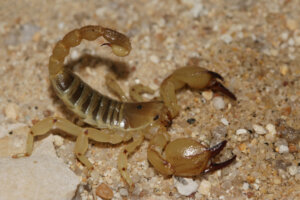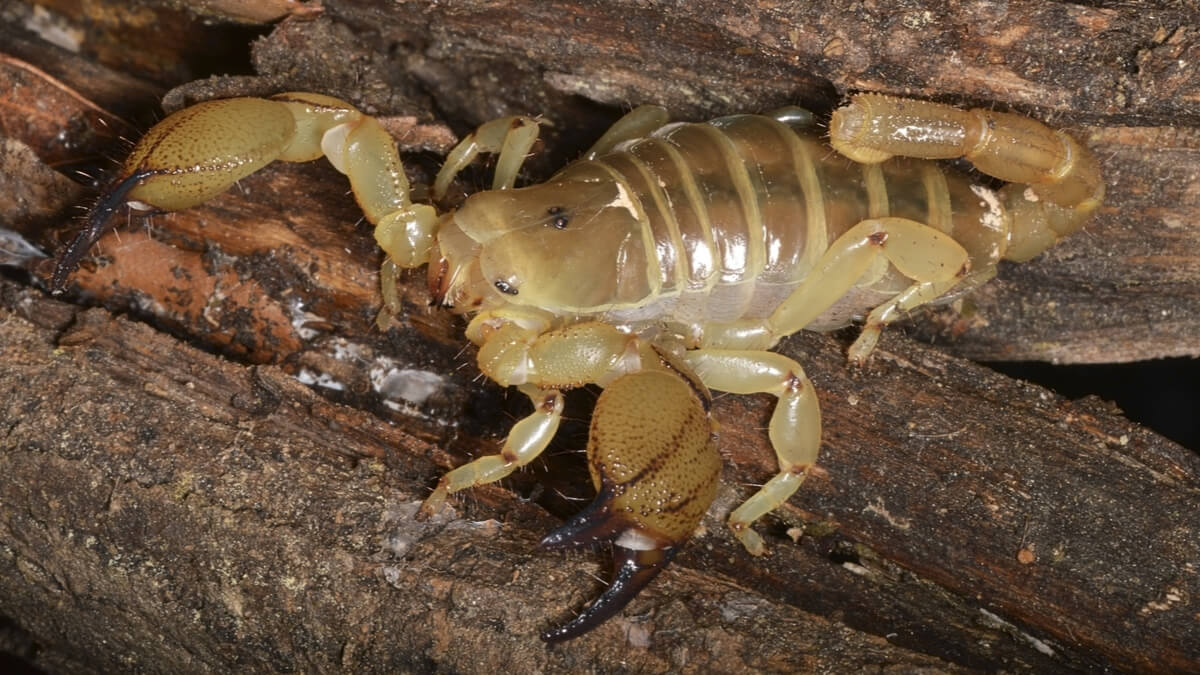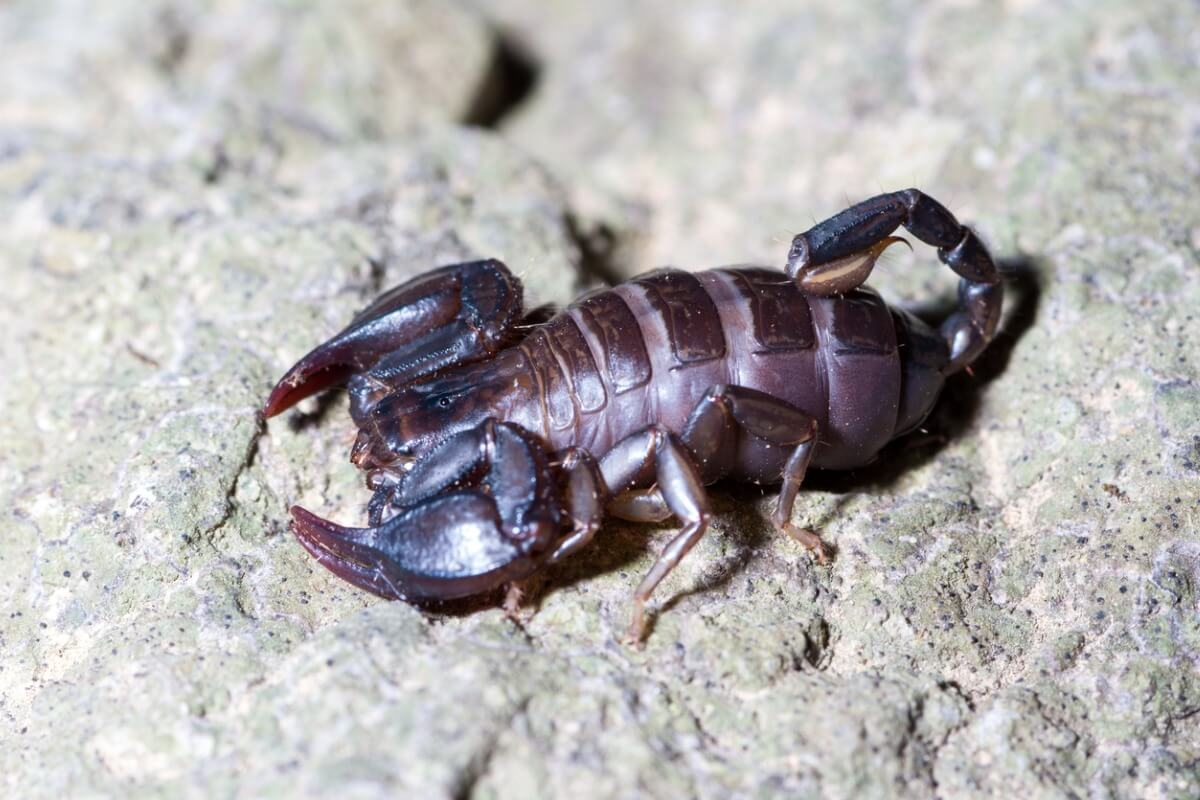5 Tips for Looking After a Scorpion


Written and verified by the biologist Samuel Sanchez
Looking after a scorpion is simple, but you must take into account a number of conditions regarding the species and the ecosystem before you decide to adopt one. Read our tips and learn how to keep one of these arachnid arthropods correctly.
The order of scorpions (Scorpiones) contains more than 2500 described species, which are distributed in 22 different biological families. The adaptability of these arthropods and their success in hunting have allowed them to adapt to several temperate and warm ecosystems. Because of this, they’re in close contact with humans in some regions.
1. Don’t take the scorpion from its environment
The first mistake many inexperienced people make is to take a living being from the wild in order to keep it in captivity. This is unethical and can seriously damage ecosystems; it has been proven that the removal of living creatures for commercial or recreational purposes initiates a decline in their populations (and therefore their extinction).
A captured scorpion will hardly ever adapt well to domestic ecosystems. In addition, it’s likely to be old, carry parasitic mites, or have some other health problem. Because of this, it’ll almost always die within a few days.
Taking animals from their natural environment is harmful in every way.
2. Choose the right species
Dozens of species of scorpions are kept and bred in captivity these days, and can be purchased in professional shops.
All scorpions are venomous, as they have a telson or stinger at the tip of their tail that connects directly to a toxin-producing gland. However, some specimens are much more lethal and aggressive than others.
For example, most scorpions of the genus Heterometrus (longimanus, laoticus, petersii and more) have very weak venom. Something similar happens with Scorpio maurus and other large scorpionids with very obvious pincers. On the other hand, representatives of the genera Tytius, Androctonus and Hottentotta can even kill a human being with their sting.
Keeping lethal scorpions requires a license and special facilities.

3. Keep the terrarium simple and utilitarian
The terrarium should always be designed with the requirements of the invertebrate in mind. A tropical scorpion of the genus Heterometrus requires 70-80% humidity and an earthy substrate, plus moss, log bark, and perhaps a plant to hide under. This general setup applies to species from humid climates.
On the other hand, a desert scorpion will require minimal humidity, very high temperatures (almost always above 25°C during the day), sandy substrate, and large stones it can hide under. It’s always best to simulate the species’ natural environment, whether it be arid or jungle-like.
Scorpions benefit from simple terrariums, as too many branches or rocks increase the likelihood of unnecessary falls or injuries. The general rule of thumb is that the setup should be 2 to 3 times the length of the animal, 2 times the width, and about 20 centimeters (8 inches) in height and have a couple of shelters (one in the cooler area and one in the warmer area).
These invertebrates don’t climb, but you’ll need to fill about half of the terrarium with substrate for them to burrow into.
4. Looking after a scorpion: you’ll need live food
Scorpions are sit and wait hunters, i.e. they wait inside their lair until an unsuspecting creature appears and kill it with the help of their sting. Being predators, they’ll only consume live prey, and no vegetable matter. However, they aren’t very active animals and have a slow metabolism.
Keeping insects as live food can be difficult for many keepers, so keep this point in mind. Most animals will be satisfied with one cricket, cockroach, or medium-sized worm per week. However, it’s very common for adult scorpions to stop eating for long periods of time before molting.
Caring for a scorpion always requires captive rearing of prey insects.
5. Don’t let your guard down and always use tweezers
Surgical or kitchen tweezers (it’s better if they’re between 10 an 20 centimeters long – 4 to 8 inches) will be your best allies when handling the scorpion’s environment. Whenever you want to remove dead food, feces, or add new prey to the terrarium, do it with tweezers, no matter how well you think you know your pet or how calm it may seem to be.
Scorpions are very bad at climbing, but they’re notorious for their speed over short distances when trying to chase their prey. They can inject their toxins into their owner’s skin in a matter of seconds. Never let your guard down and keep a distance of 15 centimeters (6 inches) or more whenever interacting with the animal’s environment.
Scorpions are unpredictable. Never reach into their terrarium with your bare hand, especially if you can’t see them.

Final recommendations
Scorpions shed their exoskeleton in a process known as ecdysis several times throughout their lives. At this time they’re very vulnerable and this is when most deaths occur, especially if young scorpions are kept in poor conditions. You’ll need to raise the humidity and remove all live prey from the terrarium to avoid mishaps at this time.
Finally, it should also be noted that scorpions are relatively long-lived, living 3 to 5 years (or much longer). Make sure you can take care of your invertebrate until its natural demise, as releasing it into the wild is never an option and is also considered illegal. Looking after a scorpion is simple, but it’s still a long-term responsibility.
Looking after a scorpion is simple, but you must take into account a number of conditions regarding the species and the ecosystem before you decide to adopt one. Read our tips and learn how to keep one of these arachnid arthropods correctly.
The order of scorpions (Scorpiones) contains more than 2500 described species, which are distributed in 22 different biological families. The adaptability of these arthropods and their success in hunting have allowed them to adapt to several temperate and warm ecosystems. Because of this, they’re in close contact with humans in some regions.
1. Don’t take the scorpion from its environment
The first mistake many inexperienced people make is to take a living being from the wild in order to keep it in captivity. This is unethical and can seriously damage ecosystems; it has been proven that the removal of living creatures for commercial or recreational purposes initiates a decline in their populations (and therefore their extinction).
A captured scorpion will hardly ever adapt well to domestic ecosystems. In addition, it’s likely to be old, carry parasitic mites, or have some other health problem. Because of this, it’ll almost always die within a few days.
Taking animals from their natural environment is harmful in every way.
2. Choose the right species
Dozens of species of scorpions are kept and bred in captivity these days, and can be purchased in professional shops.
All scorpions are venomous, as they have a telson or stinger at the tip of their tail that connects directly to a toxin-producing gland. However, some specimens are much more lethal and aggressive than others.
For example, most scorpions of the genus Heterometrus (longimanus, laoticus, petersii and more) have very weak venom. Something similar happens with Scorpio maurus and other large scorpionids with very obvious pincers. On the other hand, representatives of the genera Tytius, Androctonus and Hottentotta can even kill a human being with their sting.
Keeping lethal scorpions requires a license and special facilities.

3. Keep the terrarium simple and utilitarian
The terrarium should always be designed with the requirements of the invertebrate in mind. A tropical scorpion of the genus Heterometrus requires 70-80% humidity and an earthy substrate, plus moss, log bark, and perhaps a plant to hide under. This general setup applies to species from humid climates.
On the other hand, a desert scorpion will require minimal humidity, very high temperatures (almost always above 25°C during the day), sandy substrate, and large stones it can hide under. It’s always best to simulate the species’ natural environment, whether it be arid or jungle-like.
Scorpions benefit from simple terrariums, as too many branches or rocks increase the likelihood of unnecessary falls or injuries. The general rule of thumb is that the setup should be 2 to 3 times the length of the animal, 2 times the width, and about 20 centimeters (8 inches) in height and have a couple of shelters (one in the cooler area and one in the warmer area).
These invertebrates don’t climb, but you’ll need to fill about half of the terrarium with substrate for them to burrow into.
4. Looking after a scorpion: you’ll need live food
Scorpions are sit and wait hunters, i.e. they wait inside their lair until an unsuspecting creature appears and kill it with the help of their sting. Being predators, they’ll only consume live prey, and no vegetable matter. However, they aren’t very active animals and have a slow metabolism.
Keeping insects as live food can be difficult for many keepers, so keep this point in mind. Most animals will be satisfied with one cricket, cockroach, or medium-sized worm per week. However, it’s very common for adult scorpions to stop eating for long periods of time before molting.
Caring for a scorpion always requires captive rearing of prey insects.
5. Don’t let your guard down and always use tweezers
Surgical or kitchen tweezers (it’s better if they’re between 10 an 20 centimeters long – 4 to 8 inches) will be your best allies when handling the scorpion’s environment. Whenever you want to remove dead food, feces, or add new prey to the terrarium, do it with tweezers, no matter how well you think you know your pet or how calm it may seem to be.
Scorpions are very bad at climbing, but they’re notorious for their speed over short distances when trying to chase their prey. They can inject their toxins into their owner’s skin in a matter of seconds. Never let your guard down and keep a distance of 15 centimeters (6 inches) or more whenever interacting with the animal’s environment.
Scorpions are unpredictable. Never reach into their terrarium with your bare hand, especially if you can’t see them.

Final recommendations
Scorpions shed their exoskeleton in a process known as ecdysis several times throughout their lives. At this time they’re very vulnerable and this is when most deaths occur, especially if young scorpions are kept in poor conditions. You’ll need to raise the humidity and remove all live prey from the terrarium to avoid mishaps at this time.
Finally, it should also be noted that scorpions are relatively long-lived, living 3 to 5 years (or much longer). Make sure you can take care of your invertebrate until its natural demise, as releasing it into the wild is never an option and is also considered illegal. Looking after a scorpion is simple, but it’s still a long-term responsibility.
All cited sources were thoroughly reviewed by our team to ensure their quality, reliability, currency, and validity. The bibliography of this article was considered reliable and of academic or scientific accuracy.
- Marshall, B. M., Strine, C., & Hughes, A. C. (2020). Thousands of reptile species threatened by under-regulated global trade. Nature communications, 11(1), 1-12.
- Nirthanan, S., Joseph, J. S., Gopalakrishnakone, P., Khoo, H. E., Cheah, L. S., & Gwee, M. C. (2002). Biochemical and pharmacological characterization of the venom of the black scorpion Heterometrus spinifer. Biochemical pharmacology, 63(1), 49-55.
This text is provided for informational purposes only and does not replace consultation with a professional. If in doubt, consult your specialist.








